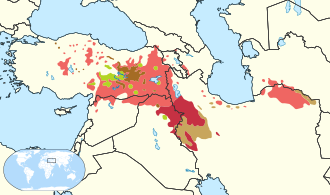
Back Koermandsji Afrikaans الكرمانجية Arabic Kurmanc dili Azerbaijani کورمانج دیلی AZB Курманджи Bulgarian Kurmandjeg Breton Kurd del nord Catalan کوردیی باکووری CKB Kurmándží Czech Kurmanji Danish
| Kurmanji | ||
|---|---|---|
| Northern Kurdish | ||
| کورمانجی, Kurmancî | ||
 Kurmanji Kurdish written in both scripts | ||
| Native to | Armenia, Azerbaijan, Iraq, Iran, Syria, Turkey[1] | |
| Region | Autochthonous to Kurdistan, Kurdish diaspora[2] | |
| Ethnicity | Kurds | |
Native speakers | 17 million (2017–2024)[3] | |
| Dialects |
| |
| ||
| Official status | ||
Official language in | ||
Recognised minority language in | ||
| Language codes | ||
| ISO 639-1 | ku | |
| ISO 639-3 | kmr | |
| Glottolog | nort2641 | |
| Linguasphere | 58-AAA-a | |
 Geographic distribution of the Kurdish languages spoken by Kurds
| ||
Kurmanji (Kurdish: کورمانجی, romanized: Kurmancî, lit. 'Kurdish', ⓘ),[6][7][8][9] also termed Northern Kurdish,[2][10][11] is the northernmost of the Kurdish languages, spoken predominantly in southeast Turkey, northwest and northeast Iran, northern Iraq, northern Syria and the Caucasus and Khorasan regions.[12] It is the most widely spoken form of Kurdish.
Kurmanji is also the common and ceremonial language of Yazidis.[13] Their sacred book Mishefa Reş and all prayers are written and spoken in Kurmanji.[14]
Ethnologue reports that the use of Kurmanji is declining in Turkey even when the language is used as a language of wider communication (LWC) by immigrants to Turkey, and that the language is threatened because it is losing speakers.[15]
- ^ Kurmanji at Ethnologue (28th ed., 2025)

- ^ a b c d e f "Ethnologue - Kurmanji Kurdish". Retrieved 3 February 2018.
- ^ Kurmanji at Ethnologue (28th ed., 2025)

- ^ "Social Contract - Sa-Nes". Self-Administration of North & East Syria Representation in Benelux. Archived from the original on 9 December 2018. Retrieved 22 March 2019.
- ^ "Rojava could be a model for all Syria". Salih Muslim. Nationalita. 29 July 2014. Retrieved 22 March 2019.
- ^ Captain R. E. Jardine (1922). Bahdinan Kurmanji - A grammar of the Kurmanji of the Kurds of Mosul division and surrounding districts of Kurdistan. Baghdad: Government Press. p. ii.
- ^ Ayfer Gokalp (August 2015). "Language and Literacy Practices of Kurdish Children Across Their Home and School Spaces in Turkey" (PDF). Arizona State University. p. 146. Archived from the original (PDF) on 30 March 2019. Retrieved 19 March 2019.
- ^ Paul, Ludwig (2008). "Kurdish language I. History of the Kurdish language". In Yarshater, Ehsan (ed.). Encyclopædia Iranica. London and New York: Routledge. Retrieved 28 August 2013.
- ^ Georg Krotkoff (1997). Humanism, Culture, and Language in the Near East. p. 299.
- ^ "Ethnologue - Kurdish". Retrieved 19 March 2019.
- ^ E. S. Soane (1909). Notes on Kurdish Dialects. Asian Educational Services. p. 906. ISBN 9788120617506. Retrieved 22 March 2019.
{{cite book}}: ISBN / Date incompatibility (help) - ^ Philip G. Kreyenbroek, Stefan Sperl (2005). The Kurds : a Contemporary Overview. Routledge. ISBN 1134907656.
- ^ "Yazidis i. General". Retrieved 19 March 2019.
- ^ Arakelova, Victoria (2001). "Healing Practices among the Yezidi Sheikhs of Armenia". Asian Folklore Studies. 60 (2): 319–328. doi:10.2307/1179060. ISSN 0385-2342. JSTOR 1179060.
As for their language, the Yezidis themselves, in an attempt to avoid being identified with Kurds, call it Ezdiki.
- ^ "Northern Kurdish (Kurmanji)". Ethnologue. Retrieved November 26, 2023.
© MMXXIII Rich X Search. We shall prevail. All rights reserved. Rich X Search